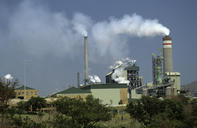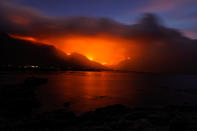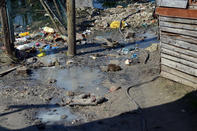Amplified Weather Patterns
When an HIV-positive person becomes immune compromised, a shortage of healthy, nutritious food becomes a matter of life or death. Slum existence is a fragile one.

These communities are poorly serviced, without easy access to clean water, flushing loos or properly constructed stormwater systems. People live in houses that are not insulated against the worst peaks and troughs of the weather, and they will be more vulnerable to the dangers associated with stagnant water after a flood, or their food might get wet and rot.
During a heat-wave, fresh food that is not stored in a fridge but on a shelf or in a cupboard in an uninsulated shack will turn more readily. And with climate change expected to amplify existing weather patterns, these communities will be at the sharp edge of the storm that is heading to our cities in the future.
Increasing concentrations of greenhouse gases in the atmosphere, linked to human activities on the planet, such as industrial-scale electricity generation, transport, agriculture and the cutting down of forests as carbon sinks, will continue to drive up air and sea temperatures around the globe. More energy in the atmospheric system means an amplified climatic system.
This means normal weather patterns, such as heat-waves, droughts, flood events and conditions favourable to fires, are likely to occur more often, and when they do, they will be harsher.
Climate Change in South Africa
In South Africa, the evidence of change is substantial, with weather trends appearing to shift away from ‘normal’ over the past six decades, and reflecting the kinds of changes seen in so many other parts of the globe. Since the 1950s, the average temperature across the region has climbed by about half a degree, with weather stations recording fewer cool days and more warm days during this time.
Sea temperatures have warmed slightly, too, and wind speed along the Cape West Coast appears to be picking up. If greenhouse gas emissions keep building up in the atmosphere at their current rate, they will push up the region’s average temperature by between at least one degree Celsius along the coast and up to three degrees in the interior by 2050.
By the close of the century, South Africa will be between three to four degrees warmer, on average, along the coastal regions, and six to seven degrees in the interior, according to the South African government’s Second National Communication submitted to the United Nations Framework Convention on Climate Change in 2008.
The upper end of these projections is well outside the kind of conditions that today’s species evolved in, or in which the past 10 000 years of human agricultural and technical development have occurred. Conditions, in essence, will be unlike anything that modern humans have known in the 200 000 years that they have been alive.
It is much harder to project how rainfall will change, but for the Western Cape, with its winter rainfall and naturally drought-stricken summers, the region will get drier overall – early projections are for a 25% decrease in winter rainfall – with occasional bouts of severe flooding.
Some of the wetter parts of southern Africa, where summer rainfall conditions prevail, may see an increase in rainfall. And when the rainstorms come, they are likely to drop more rain during each storm event. But these might be interspersed with longer dry spells in between – so there will be heavy flooding, punctuating longer periods of drought.
Limited Water in South Africa

In South Africa – and the same is probably true for the SADC region – ‘water is arguably the primary medium through which climate change impacts will be felt by people, ecosystems and economies...since many of South African ecosystems are climate-and water-dependent.
Water resources are limited in South Africa, and thus constitute a major constraint to continued economic development and the sustainable livelihoods of people’, states the Second National Communication. City managers need to gear themselves for managing a new breed of extreme weather events: the usual kind of flood, dry spell or heat-wave, but on steroids.
They will come more often, and when they do, they will be stronger and more intense. Naturally, limited water supplies will hit the very top end of the food value chain – agriculture – since this is the region’s largest water consumer. But in South Africa, it will put farmers in greater competition with non-agricultural users.
The water that is there is already becoming more polluted as a result of the extent to which our industries are stretching the system, both in terms of extracting water and in terms of dumping dirt into the water system.
Now, ‘increases in physical, chemical and biological pollution from flooding, soil erosion, agricultural and industrial solutes, poor sanitation and increased temperatures will adversely affect both surface water and groundwater quality in the absence of adaptation responses’.
In the Cape, increased ‘fire weather’ is expected. This is what scientists call the kind of fire-conducive conditions that come with spiking temperatures, drying of the air and soil, and faster wind speeds. Given how notoriously fire-prone slums are, with their close confines, paraffin stoves, open flames for light and the materials used to build informal structures, this does not bode well for communities where fires often ravage settlements in summertime.
Food Poisoning and the Food Value Chain
The extremes associated with a shifting climate also have implications for food safety. There are already numerous studies showing the link between high temperatures and everyday forms of food poisoning such as salmonella, according to the Intergovernmental Panel on Climate Change (IPCC), an international collaboration of scientists operating under the United Nation’s Framework Convention on Climate Change.
‘Contact between food and pest species, especially flies, rodents and cockroaches, is also temperature-sensitive. Fly activity is largely driven by temperature...In temperate countries, warmer weather and milder winters are likely to increase the abundance of flies and other pest species during the summer months, with the pests appearing earlier in spring,’ the IPCC states in its 2007 report.
There are multiple points along the food value chain where climate change will undermine food security, both regionally and at a household level. Obviously, agricultural output will suffer from the impact of increased storms, heat-waves, droughts, pest activity and diseases.
Climate change will redraw the map of southern Africa, in terms of what we can grow, and where we can grow it. When the amount of food in the national basket decreases – and climate change will cause a decline in yields from time to time, or change the seasonality and thus availability of certain foods – the result is that food prices go up.
The ripple effect, down to the other end of the food value chain, is that food becomes unaffordable for the poor, which will undermine their health and nutrition.
This is particularly serious for HIV-positive people and those on antiretrovirals who have greater need for good nutrition. Extreme weather events might also disrupt the flow of food into cities – a washed-away bridge, for instance, could pinch off an important supply route for shipping food into the city.
Extreme Weather and Disease

The kinds of extreme weather events associated with climate change are likely to aggravate the already precarious water access issues that people in slums and other poorly serviced areas of the metropole are burdened with, both in terms of basic health issues and in terms of food safety.
According to the Intergovernmental Panel on Climate Change (IPCC), the link between availability of water, household access to clean water and the burden of diarrhoeal disease is one of the main areas of concern when considering the relationship between health and exposure to changes in rainfall, water availability and water quality.
Extreme weather events resulting in intense rainfall will have implications for outbreaks of any waterborne diseases that could contaminate a city’s water supplies, bringing disease either through the municipality’s reticulation system or through the surface water.
Climbing temperatures and changes in runoff can also cause coastal, surface and recreational water to become contaminated, either microbially or chemically, and there are the direct effects of rising temperature on the incidence of diarrhoeal disease, according to the IPCC.
‘Extreme rainfall and runoff events may increase the total microbial load in watercourses and drinking-water reservoirs.’ Similarly, droughts bring their own risk of waterborne disease. Once rivers run low during dry spells, any contamination of a river system becomes more concentrated, increasing the ‘pathogen loading’ in the system. ‘Access to safe water remains an extremely important global health issue.
More than two billion people live in the dry regions of the world and suffer disproportionately from malnutrition, infant mortality and diseases related to contaminated or insufficient water,’ the IPCC claims. Children in low-income communities are particularly at risk of diarrhoea-type disease, especially if they live in slums.
The IPCC documents the association of cholera outbreaks with flood events and faecal contamination of the water supplies in sub-Saharan Africa. And there is a strong correlation between gastro-intestinal infections like this and increased rain in the normal rainy season.
Rising temperatures have also been associated with increases in diarrhoea in both adults and children – something which might exacerbate the health problems of people who are running low on basic calories or long-term nutrition.
By Leonie Joubert